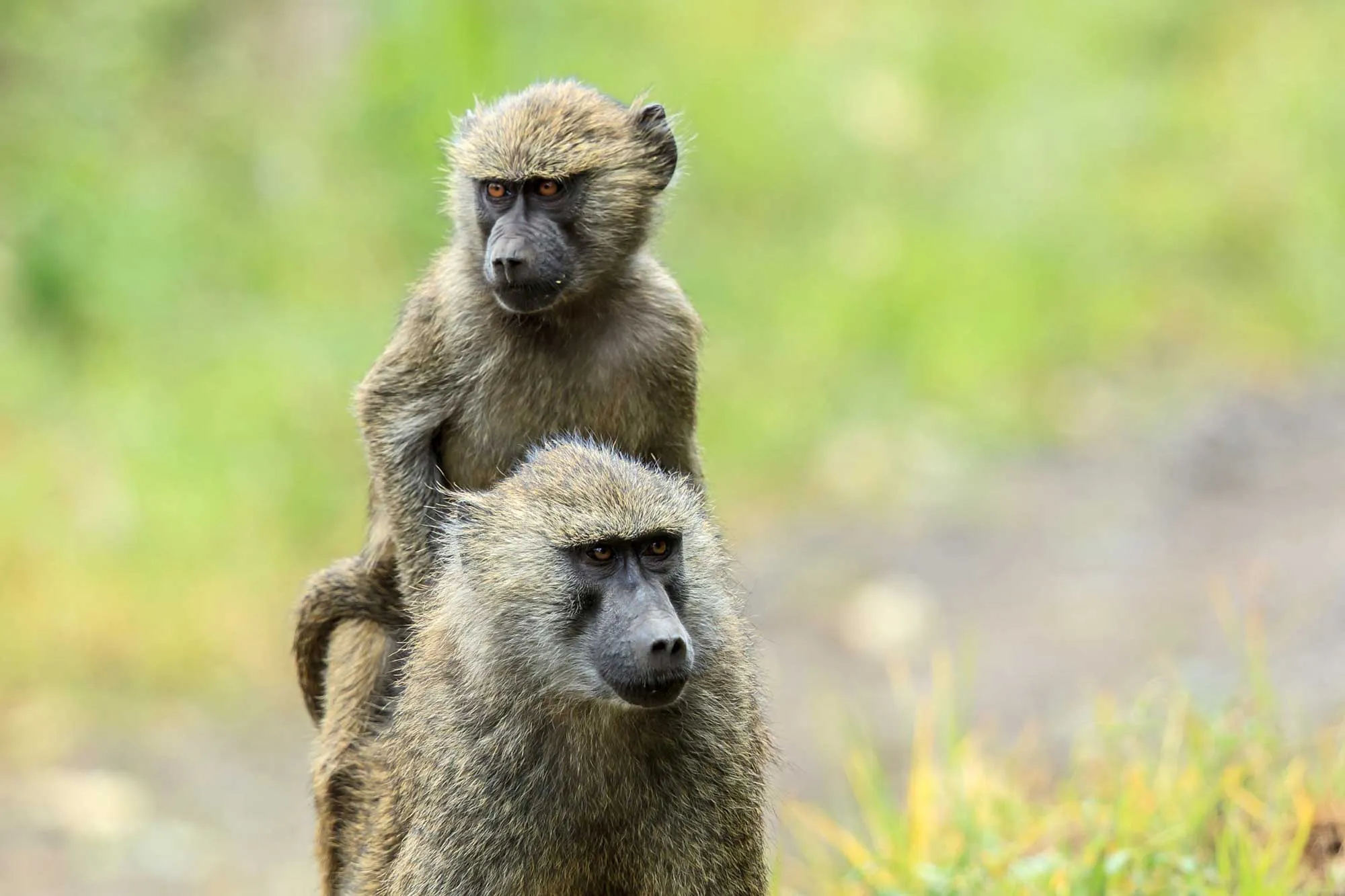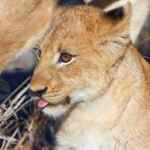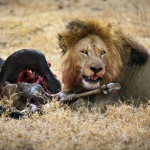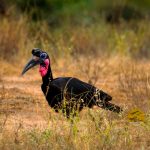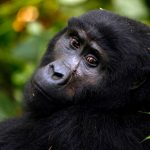Olive Baboons in Uganda: The Amazing Life of Social Primates.
Olive Baboons in Uganda; Uganda is a treasure trove for fauna lovers, holding a rich mix of flora and fauna that attracts adventurers from all over the world. Among the many thrilling animals that call Uganda home, one charismatic yet complex primate is the olive baboon, Papio anubis. Olive baboons, with their greenish-grey fur and unique social structures, inhabit nearly all national parks, forests, and even the edges of human settlements across the country. Highly adaptable and intelligent socially, they remain one of Uganda’s most interesting wildlife residents.
The Physical Traits of the Olive Baboon.
They are called olive baboons due to their distinctive olive color. They are muscular yet agile primates with prominent faces that feature a muzzle and expressive eyes. Males have long, sharp canine teeth and an impressive mane around their necks. Adult males weigh between 22–37 kg (48–82 lbs), while females are much smaller, weighing 12–18 kg (26–40 lbs).
Olive baboons live in enormous, organized social groups and exhibit a wonderful range of behaviors. Their lives intertwine with Uganda’s wild landscape, from open grasslands to dense forests.
Life Span and Gestation of Olive Baboons.
In the wild, olive baboons are said to live up to about 25 to 30 years; however, this may be longer in protected areas or in captivity. Causes of death among these primates will vary due to predation, disease, and human interference. A female baboon has an infant after a six-month gestation period, approximately 180 days. A long gestation period allows time for the young baboons to develop so that they can be relatively advanced at birth.
Females are highly invested in their juveniles, nursing and carrying infants for months after birth. Young baboons learn through observation and participation with other troop members, learning survival skills over time.
Social Structure and Behavior of Olive Baboons.
Olive baboons live in large, multilevel social groups, or troops, with sizes varying from several dozen to over a hundred members. Every troop has an orderly hierarchy of both males and females. Dominant status of males is acquired through competition, often in coalitions, which increases the likelihood of high social status and mating. Females stay in their natal group and develop bonds with other females, establishing stable matrilines, which are the source of troop cohesion.
Communication is imperative in these groups, and olive baboons have a good array of vocalizations, postures, and facial expressions. Alarm calls such as deep barks raise others, while softer grunts show friendship and basically ease tensions. The most common social behavior of grooming helps bond group members together and is a natural stress reliever. The baboon society is uniquely structured, each member holding some kind of role and rank.

Where to Find the Olive Baboons in Uganda.
Olive baboons are one of the commonest sights in a number of Ugandan national parks and reserves where they thrive in different habitats, from savannas to woodlands. Here are some of the best places where you can get a clear glimpse of this amazing primate up close:
1. Murchison Falls National Park
The other great place to view olive baboons is Murchison Falls National Park, Uganda’s largest park. They are usually viewed around the main entrance and along the trails to the waterfall. At this place, one can often see baboons on the Nile River banks as they converge to feed and socialize with each other, offering great sights of their social nature.
2. Queen Elizabeth National Park
Queen Elizabeth National Park remains the best place in Uganda for observing olive baboons. Here, they are found along main roads, at the Mweya Peninsula, around the Kazinga Channel. The park guarantees excellent opportunities to see baboon troops interacting, grooming, or foraging along the sides of roads as they are not that shy of vehicles.
3. Kibale Forest National Park
The mainly known Kibale Forest National Park for its chimpanzee is also a home to olive baboons, especially around the edges of the park and more open areas; Often times baboon visitors can be seen near the entrance and along roadsides, thereby affording them an opportunity to have a great view of them in the forested environment. Kibale provides a more somber and tranquil setting in which to observe among Broker greenery behavioral patterns of the baboon.
4. Lake Mburo National Park
Another good place to take an olive baboon tour is Lake Mburo National Park, with its disparate landscape of savannas and woodlands; Baboons are commonly seen along the main roads in this park and can be accessed at great proximity with wide clear views of their foraging and social behaviors. This is a great open landscape in which to see these animals in their natural environment.
5. Bwindi Impenetrable National Park
Bwindi Impenetrable National Park is most famous for mountain gorillas, but visitors may occasionally spot olive baboons along the park’s more open fringes. Although less frequent than in other parks, baboon troops can sometimes be seen snacking and playing at the forest edges.
6. Toro-Semliki Wildlife Reserve
Toro-Semliki Wildlife Reserve is only a short distance from the base of Rwenzori Mountains and offers ideal olive baboon habitats combined with savanna and riverine tracts of land. It is less touristy than other destinations and may thus allow for a more personal experience in viewing them. The olive baboons cross open plains as they move along the Semliki River and are usually seen in large social groups.
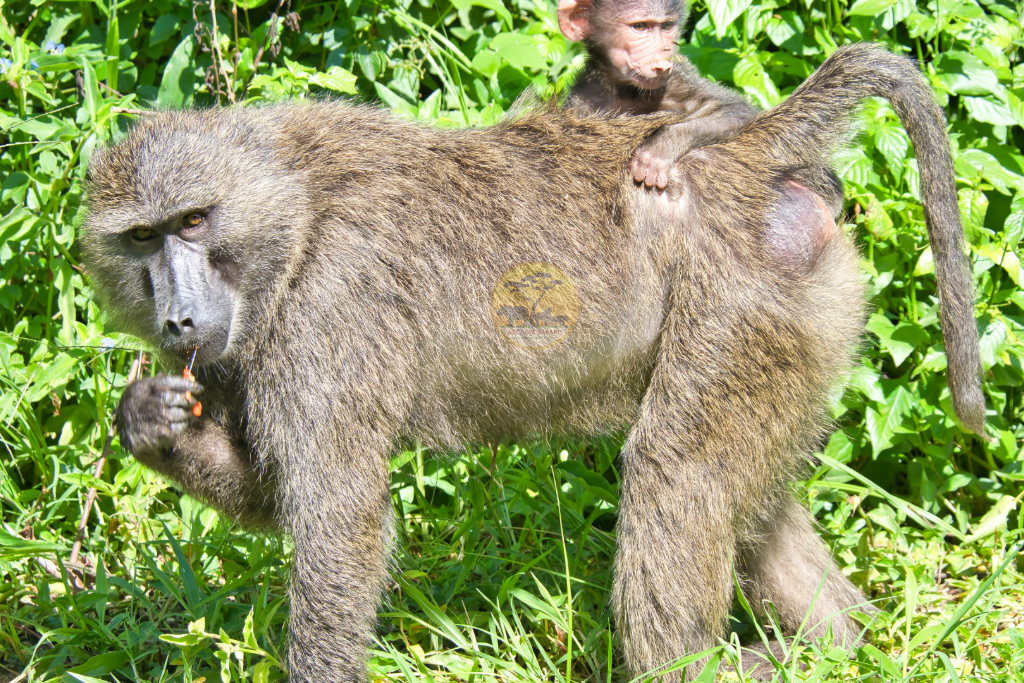
Diet and Foraging: The Omnivorous Appetite.
The diet of the olive baboons is very flexible; thus, it ranges from fruits, seeds, and leaves to flowers and insects as well as small animals. Such an omnivorous diet also allows adaptation toward seasonal changes in the available food. During drier seasons, such species may be drawn closer to human settlements and farmland, where they often clash with residents by raiding crops.
But the most interesting thing to watch is their foraging behavior where, sometimes, baboons will have fantastic problem-solving skills by cleverly getting out containers, opening up bags, and even colluding in many ways for food access.
Life Cycle and Parenting: From Infant to Adult.
Baboon females give birth, after a gestation period of about six months, to a single infant. Mother baboons are very attentive to their young: they take them everywhere, providing them with all the care and protection they need; The bond between mother and young is crucial since young baboons acquire their important survival skills from observing and interacting with their mothers and other troop members.
Juveniles are very active and playful, engaged in mock fights and chasing games, and such activities help the youngsters make social bonds and achieve agility; During adolescence, males will usually leave the natal troop to join another; the behavior would avoid inbreeding and enhance genetic diversity in the population; Females, on the other hand, typically remain in the birth troop, building a network of female friendships to stabilize the troop.
Predators and Threats for Olive Baboons.
In the wild regions of Uganda, olive baboons face several threats from predators like leopards, lions, and big birds of prey such as crowned eagles. To survive, baboons rely on their intelligence and social structures. Normally, sentinels are put to watch for any danger or to alert the troop by loud alarm calls. If a predator is around, they are likely to scatter, ascend trees, or make circles to protect their juveniles.
Other major threats to baboons include human activities, especially habitat loss from increasing agriculture and urbanization, which deprive the animals of their natural territories. Some people may consider baboons pests due to crop raiding and thus might take action against them. In the case of Uganda, efforts related to habitat conservation, awareness, and coexistence with baboons have always been at the front in mitigating the outlined challenges.

Conservation Status and Efforts.
Although baboons have an “Least Concern” status in the IUCN Red List, they nonetheless face serious threats from habitat loss and human-wildlife conflict. In Uganda, different organizations are involved in the active protection of baboon populations, striving for a sustainable coexistence. They protect natural habitats and involve communities in understanding the importance of biodiversity. It is through such conservation efforts that Uganda seeks to ensure that these interesting primates have a promising future.
Interesting Facts About Olive Baboons.
Socially Complex: These primates are known to establish complex social hierarchies where both males and females have separate dominance lines.
Intelligent Forager: Some call them problem solvers since the baboon can adapt to whatever food items are available within a very short time.
Strong Family Bonds: Female olive baboons develop lifelong friendships with relatives, therefore building up support networks within their troops.
How to Observe Olive Baboons in Uganda.
The appearance of an olive baboon in Uganda forms part of lifetime memories for any wildlife enthusiast. The national parks which give an opportunity to have views of these baboons in their natural habitats include Queen Elizabeth, Murchison Falls, and Kibale; It is so interesting to observe how the olive baboons go about their business, grooming one another, foraging for food, or keenly observing their surroundings for any sign of a predator.
This adds value to the voyager because most companies, like Arcadia Safaris, offer guided tours, and in most cases, such guides possess substantial information on baboon behaviors, ecology, and conservation; It therefore means that it provides an opportunity for learning, which enables one to appreciate the rich biodiversity that Uganda has and the crucial role that primates play in maintaining healthy ecosystems.
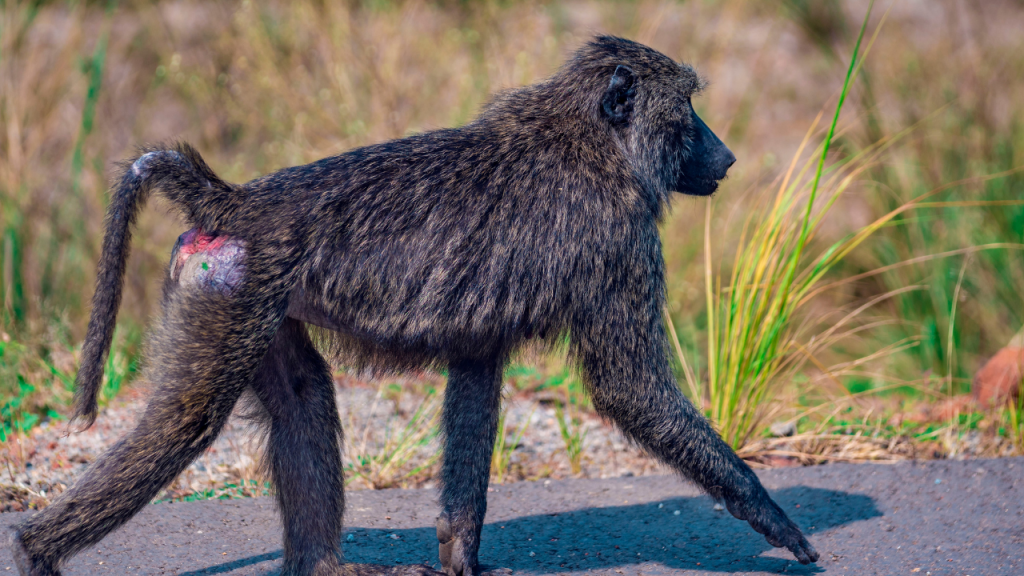
Our Remarkable Uganda Primates Safaris.
22 Days Best of Uganda Wilderness Adventure
18 Day Exploring Uganda Safari
15 Day Gorillas-Chimps and Big Five Safari
14 Day Uganda-Rwanda Wildlife and Primates Safari
10 Day Uganda Wildlife and Primates Safari
10 Day Highlights of Uganda Safari
3 Day Gorillas and Lake Bunyonyi Safari
8 Day Gorillas-Chimps and Big Five Experience
7 Day Murchison Falls with Chimps and Gorillas
6 Day Gorilla Trekking and Queen Elizabeth
5 Day Gorillas and White Water Rafting
4 Day Kibale Forest Chimpanzee Tracking
3 Day Gorilla Trekking and Batwa Trails in Bwindi
3 Day Fly to Bwindi Gorilla Safari
Comments on Olive Baboons in Uganda.
From common sight to an integral part in the balance of the ecosystems, the olive baboon is an emblem in Uganda for adaptability and social complexity. One sight of these ingenious resourceful animals strikes a powerful reminder in the direction of wildlife conservation. Secondly, the national parks and conservation efforts in Uganda ensure that future generations will also enjoy and learn from this great primate; If ever you get to go to the place, make it a point to spend some time observing olive baboons in nature – that would be a glimpse into the pulsating social life of one of the most adaptable African species.

